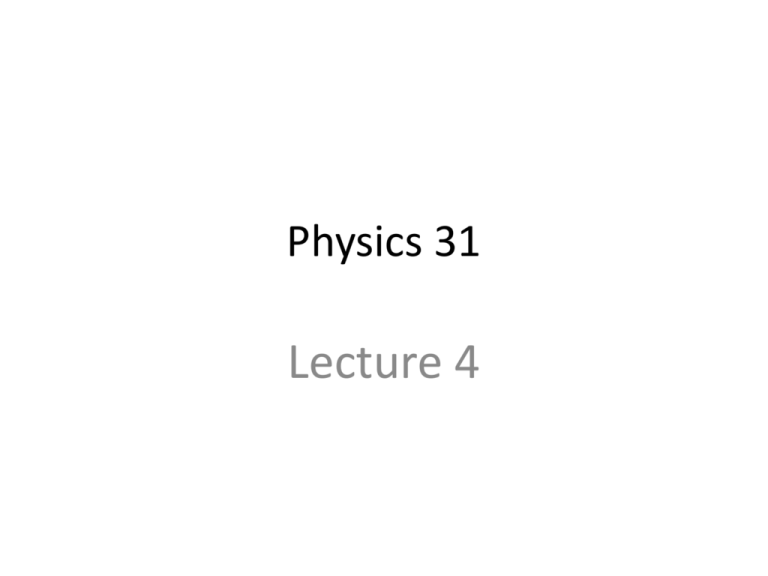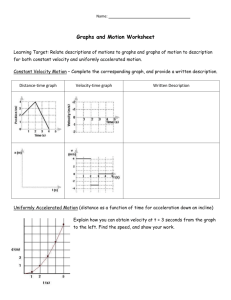Physics 31
advertisement

Physics 31 Lecture 4 Clicker Test 1. 1 2. 2 2 3 4 5 6 7 8 9 10 21 22 23 24 25 26 27 28 29 30 11 12 13 1 1 14 0% 15 16 17 18 2 0% 19 20 Chapter 2 Motion in One Dimension Topics: • The kinematics of motion in one dimension • Problem-solving strategies • Free fall Sample question: Horses can run much much faster than humans, but if the length of the course is right, a human can beat a horse in a race. When, and why, can a man outrun a horse? Slide 2-1 Looking Back: What You Already Know From this class: • In Chapter 1 you began studying motion in one dimension. We continue the development of the concepts in this chapter. • In Chapter 1 you saw how to represent motion using a motion diagram. In this chapter we will look at other ways to represent motion. From previous classes: • We will use graphical representations of motion extensively in this chapter. You should have learned how to draw, interpret, and work with graphs in previous courses. Slide 2-2 Representations Motion diagram (student walking to school) Table of data Graph Slide 2-9 Solving Problems Slide 2-10 Solving Problems (continued) Slide 2-11 Interpreting Graphs Slide 2-12 Checking Understanding Here is a motion diagram of a car moving along a straight stretch of road: Which of the following velocity-versus-time graphs matches this motion diagram? A. B. C. D. Slide 2-13 Answer Here is a motion diagram of a car moving along a straight stretch of road: Which of the following velocity-versus-time graphs matches this motion diagram? C. Slide 2-14 Checking Understanding A graph of position versus time for a basketball player moving down the court appears like so: Which of the following velocity graphs matches the above position graph? A. B. C. D. Slide 2-15 Answer A graph of position versus time for a basketball player moving down the court appears like so: Which of the following velocity graphs matches the above position graph? C. Slide 2-16 Checking Understanding A graph of velocity versus time for a hockey puck shot into a goal appears like so: Which of the following position graphs matches the above velocity graph? A. B. C. D. Slide 2-17 Answer A graph of velocity versus time for a hockey puck shot into a goal appears like so: Which of the following position graphs matches the above velocity graph? D. Slide 2-18 Examples A soccer player is 15 m from her opponent’s goal. She kicks the ball hard; after 0.50 s, it flies past a defender who stands 5 m away, and continues toward the goal. How much time does the goalie have to move into position to block the kick from the moment the ball leaves the kicker’s foot? Cleveland and Chicago are 340 miles apart by train. Train A leaves Cleveland going west to Chicago at 1:00 PM, traveling at 60 mph. Train B leaves Chicago going east to Cleveland at 2:00 PM, going 45 mph. At what time do the two trains meet? How far are they from Chicago at this time? Slide 2-19 The slope at a point on a positionversus-time graph of an object is 10 21 22 23 24 25 26 27 28 29 30 13 14 15 by ... .. 0% st a nc e tra ve le d ra ce le ac 16 0% t io n e. .. ta n sta n in je ct ’s av er ag ev el o th at 12 je ct ’s sp ee d je ct ’s 11 di 9 0% 17 th e 8 ob 7 th e 6 ob 5 .t he 4 ob 3 th e ob 2 th e 1 0% ... .. 0% je ct ’s A. the object’s speed at that point. B. the object’s average velocity at that point C. . the object’s instantaneous velocity at that point. D. the object’s acceleration at that point. E. the distance traveled by the object to that point. 18 19 20 The area under a velocity-versustime graph of an object is ... of th ea ft he 0% bo ve 0% No ne en to ac em sp l di th e 0% by ... .. tra nc e st a di th e ob je ct ’s ac ce le ra at sp ee d je ct ’s th e ob th e 0% t io n th .. 0% ve le d A. the object’s speed at that point. B. the object’s acceleration at that point. C. the distance traveled by the object. D. the displacement of the object. E. None of the above Homework for today • Problems: 1: 28, 30, 32, 35, 43, 47, 51, 56 Homework for Friday • Reading: 2: 3-4 • Problems: 2: CQ1, CQ6, MC18, 1, 3, 5, 8, 12





